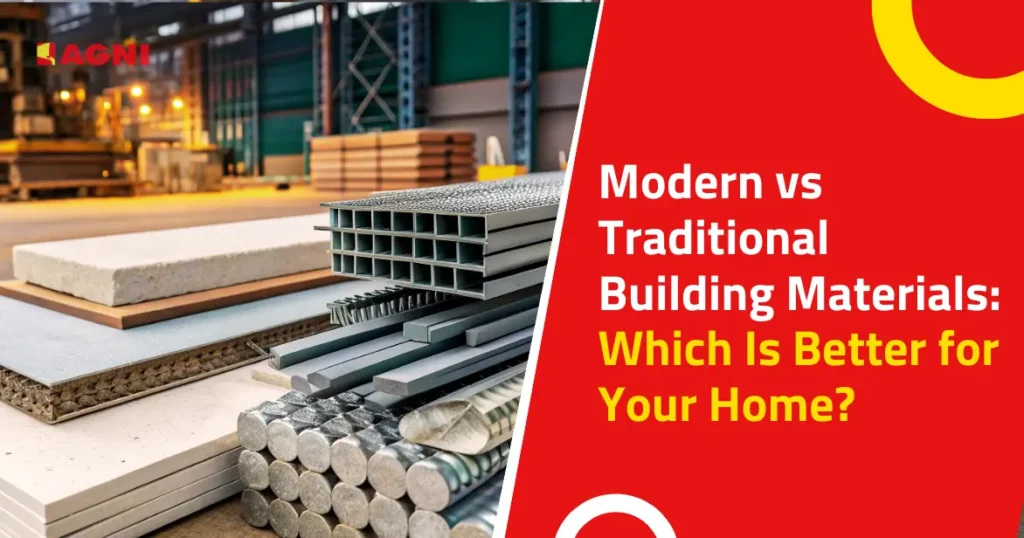For every hustler working for their dream, the biggest decision of life is building a house. However, it doesn’t come easily and requires a lot of decision-making. From design and budget to selecting the right construction materials, every aspect plays a significant role in determining the strength, durability, and comfort of your home. With a plethora of options, many homeowners struggle to choose between modern and traditional building materials. Let’s understand the difference and determine which one is better suited to your needs.
What Are Traditional Building Materials?
Traditional building materials are centuries-old materials and techniques that have been used in construction. Some of them include clay, wood, stone, lime, mud, bamboo, and bricks. Often locally sourced, they have strong cultural and regional significance. For example, village huts are still made of mud and clay bricks to keep them cool in the summer.
What Are Modern Building Materials?
Modern building materials are recently developed products that use the latest technology to improve strength and durability. Some common examples are concrete, steel, glass, aluminium, gypsum, plastic composites, and fibre cement boards. These are widely used in urban construction for homes, offices, and skyscrapers.
Key Differences Between Modern & Traditional Materials
The main difference lies in composition, durability, and sustainability.
Traditional building materials are natural and eco-friendly, but may need more maintenance. On the other hand, modern building materials are stronger and longer-lasting, but they are mass-produced using industrial methods that are not environmentally friendly.
Pros & Cons of Traditional Building Materials
The difference between CRS TMT bars and regular TMT bars is as follows:
Pros:
- Eco-friendly and biodegradable
- Easy to source and locally available
- Maintenance: CRS TMT bars require minimal maintenance, as the coating is protective and resists rusting.
- Natural temperature regulator, keeping homes cool in summer and warm in winter
- Pocket-friendly method
Cons:
- Require frequent maintenance
- Lacks resistance to fire, water, and pests
- Limited capacity for multi-storey housing
Pros & Cons of Modern Building Materials
The difference between CRS TMT bars and regular TMT bars is as follows:
Pros:
- Highly durable
- Better resistance to fire, water, and pests
- Suitable for all kinds of structures
- Require less maintenance
Cons:
- More expensive than traditional materials
- Causes production pollution
- Less biodegradable
Cost Comparison
Traditional building materials are cheaper at the initial stage, but cost a lot of maintenance later on. Whereas modern building materials are costly but offer longer life and reduced upkeep. In the long run, modern materials are more cost-efficient for permanent homes.
Strength & Durability Comparison
Speaking of strength and durability, modern building materials obviously have the upper hand. They can easily bear heavy loads and last for decades without any damage. Traditional building materials, however, may weaken over time or get damaged by moisture, termites, or weather.
Sustainability & Environmental Impact
Sustainability is a key concern in today’s world.
Traditional building materials, in general, are more eco-friendly and renewable. On the other hand, modern materials can be changed into sustainable choices through the latest developments like recycled steel, fly-ash concrete, and solar-reflective glass.
Safety & Fire Resistance
One of the major factors for any home is safety. Modern materials are usually fire-resistant and meet strict safety standards. In contrast, traditional materials such as wood or thatch are highly flammable and may not meet modern safety codes.
Which Is Better for Home Construction?
Whether to choose modern or traditional materials depends on your needs, location, and budget. For rural homes, traditional materials are often well-suited. For city homes that require high strength, low maintenance, and modern aesthetics, contemporary materials are the ideal choice for house construction.
Best Materials for Different House Types
- Nature-Inspired homes: Bamboo, mud blocks, natural stone
- City apartments: Concrete, steel, glass
- Beach houses: Fibre cement, treated wood, and corrosion-resistant steel
- Luxurious homes: Glass, marble, and modern composites
How to Choose the Right Material for Your Home
Before moving forward, think about your climate, budget, site, and long-term objectives. Alternatively, you can have both the materials.
Use traditional materials in the interiors for a natural appearance and modern materials in the exterior for safety and longevity. This combination offers a perfect balance of beauty and sustainability.
Conclusion
Modern building materials, as well as traditional ones, each have benefits and disadvantages. The best materials for house construction are those that meet your specific requirements. The wise choice is to construct a house that has both a solid built-up and durability for many generations.


